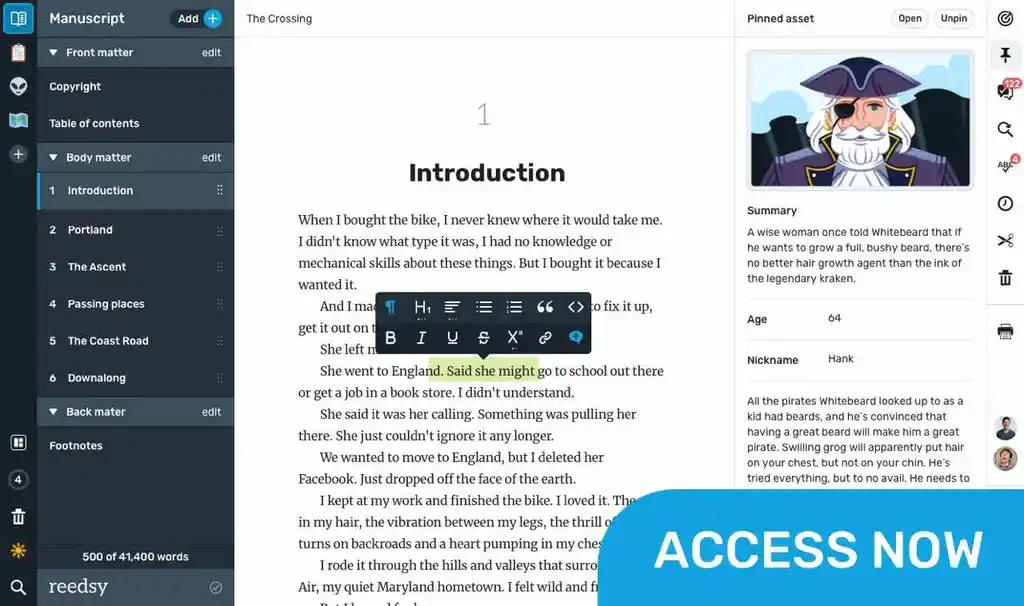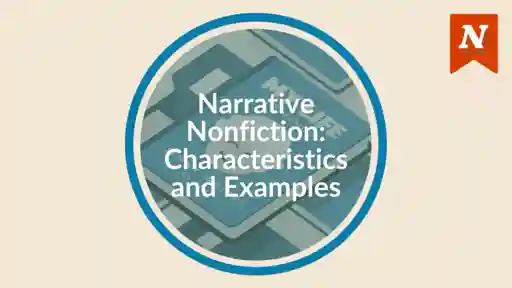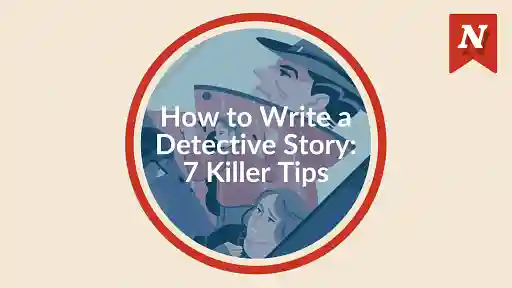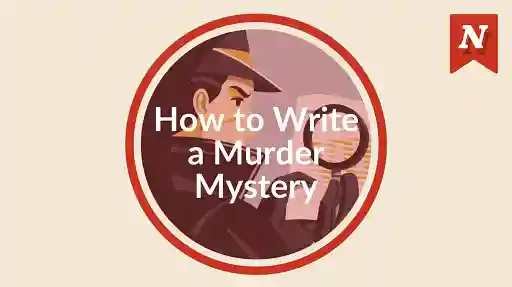Which came first: the chicken or the egg? We may never know the answer to this age-old question, but fortunately we do know the answer to another chicken-adjacent adage: why it chose to cross the road.
Perhaps you’re a writer who, like the humble chicken, has reached a crossroads. You want to write a funny story, but you aren’t quite sure how to go about it.
Consider this post your beginner's guide to writing comedy. We’ll walk you through the process, with some comedy-writing tips from professional comedians and examples from well-known funny stories sprinkled in along the way.
Find your comedic voice
Trying to craft a joke that everyone will find funny is like asking our poor chicken to cross the autobahn — it’s not going to go well. A joke that one person finds gut-bustingly hilarious might fall completely flat with someone else. So cast aside any foolish notions you may have of universal comedic appeal, and embrace the quirks that make your sense of humor unique.
You may have to do some soul-searching here: what do you find funny? This sounds straightforward enough, but it can be a little more zigzag-backward than you might expect. After all, most people don’t actively think about what tickles their funny bone. But just as you’ll never make it on Broadway if you aren’t sure whether you’re a soprano or a contralto, you’ll never find your comedic voice if you can’t pin down what gives you the giggles.
Let’s take a quick look at some comedic writing in action to help you refine your own style.
🌍 Deadpan absurdism in Discworld
Terry Pratchett’s Discworld is known for a lot of things: imaginative fantasy worldbuilding, compelling character dynamics, and poignant social commentary. But it’s Pratchett’s trademark dry wit that really sets his work apart.
If there’s one surefire way to make a joke funnier, it’s by explaining it — so that’s what we’ll do. Take this line from Monstrous Regiment. For context, Igorina hails from a clan known for swapping body parts through cosmetic surgery:
“Igorina had good eyes. Polly wondered if they’ve ever belonged to someone else. She gave Polly a wink and held up a thumb. It was, to Polly’s relief, one of her own.”
Here, Pratchett starts with an innocent observation, twists it into something darkly comedic, then lands on a final beat that’s bleak, yet wholesome.
This line isn’t just funny — it also tells us something about the characters and the relationship they share. Igorina is helpful, cheery, and oblivious to the mild unease that her appearance instills in her pocket sized companion. A one-two punch of comedy and characterization!
🍷 Self-serious melodrama in The Dead Friend Project
In Discworld, we tend to laugh with the characters. Even if a gag is at their expense, the character in question is typically in on the joke as well. This is decidedly not the case in The Dead Friend Project.
Joanna Wallace’s cast of pretentious parents carry themselves with the utmost importance. They're convinced that their playground drama is life-or-death, their parenting methods are unprecedented, and their children are intellectual prodigies:
“Do you know, since I started doing extra story time with Noah every day, he’s moved up four reading levels in less than a term. At this rate,” she adds, clipping the hand sanitiser back onto her belt, “he’ll be a gold level reader by the end of Year Three!”
“Four reading levels in less than a term? That’s a Herculean achievement,” says Fara. “Congratulations to you and Noah.”
A gold level reader, by the end of Year Three!? Truly, we have a young Socrates in our midst.
Well, not quite. These parents may believe that their little tykes’ academic prowess will make or break their future prospects, but we readers know better. Believe it or not, one’s likelihood of taking home a Nobel Prize is not entirely determined by one’s reading level at seven years old. This air of manufactured self-importance is baked into every schoolyard interaction, and the narrator is the only one to acknowledge the absurdity of it all.
Of course, Pratchett and Wallace’s signature sarcasm may not be for everyone. Perhaps you’re more partial to P.G. Wodehouse’s wordplay, which relies more on timing, misunderstandings, and awkward etiquette, or the witty irreverence of a Christopher Moore novel.
Whatever the case may be, once you’ve determined what you find funny, you can begin implementing it in your writing. And what better place to begin than with your characters?
Create comedic characters
A story isn’t just a series of interconnected events. It’s the tale of a specific person — your protagonist. So, if you want your story to be funny, you’ll need to write a main character with some serious comedic chops… or not! There’s more than one way to skin (or save!) a cat, after all.
Your protagonist doesn’t necessarily need to be a Robin Williams-esque one-liner machine for your story to be funny. In fact, you can write a side-splitting story with the driest, most yawn-inducing main character you can imagine. In the immortal words of comedian Usama Siddiquee, “contrast is the basis of all humor.” Ergo, you just need to make sure your protagonist’s personality creates some kind of comedic contrast with another character.
There are dozens of comedic archetypes across fiction (the buffoon, the narcissist, the eccentric, etc,) but they can broadly be divided into two categories: the funny man and the straight man. We’ll cover both here.
😛 The funny man
If you ever hear a “crash, bang, wallop,” in a story, it’s probably the work of the resident funny man. This archetype typically takes one personality trait and dials it up to eleven, whether that’s impulsivity, obliviousness, or eccentricity. Think Bertie Wooster from P.G. Wodehouse's Jeeves and Wooster stories, or Dwight Schrute from The Office.
The funny man doesn't need to be self-aware about their humor (in fact, they're often funnier when they're not). They can be a lovable fool who can’t help but stumble into disaster, or an overconfident ignoramus whose harebrained schemes always seem to backfire. Regardless, their job is simple: create comedic chaos for the straight man to react to. Speaking of which…
😐 The straight man
For every Laurel, there is a Hardy. The “straight man” (or woman) is exactly what it sounds like — a character that doesn’t play into the absurd shenanigans that the funny man concocts. They’re typically intelligent, sarcastic, or aloof, à la Don Quixote's trusty sidekick, Sancho Panza, or Arthur Dent from The Hitchhiker's Guide to the Galaxy.
Very few stories are all giggles all the time. If you want to make sure your jokes land, it’s important to keep things grounded with a little bit of gravity every now and then. As comedian Steve Martin once said: “chaos in the midst of chaos isn't funny, but chaos in the midst of order is.”
The straight man provides that order — they give readers a relatable perspective to latch onto, and a straightlaced foil for the funny man to bounce off. But that doesn’t mean that the straight man can’t be funny in their own right. Sometimes, it’s precisely because they’re laced so tightly that they leave readers in stitches.
The straight man and comic relief dynamic is just that: a dynamic. Different characters can take on different roles depending on the situation. You can even flip-flop between them mid-scene!
As long as you maintain a comedic contrast between your characters, you’ll have the freedom to shift the dynamic in whichever direction you so please. In fact, you’ll kick your comedy writing up a notch if you can do so effectively, since you’ll expand your funny-writing repertoire exponentially.
Learn how to subvert expectations
So, why did the chicken cross the road? Because he left his wallet in the intro.
That right there is a classic misdirect, a core tenent of comedy writing. The setup leads readers to anticipate a familiar conclusion, only to blindside them with an unexpected twist. I even threw in a call back to an earlier joke for good measure.
Of course, you shouldn’t subvert expectations just for the sake of it. Susan Harris (creator of The Golden Girls) once said that “silly isn’t funny.” In other words, simply subverting expectations isn’t enough — how you go about it is much more important. Here’s a quick example to demonstrate the difference.
🦒 Subverting expectations in action
Let's say we’re writing a story where the protagonist enlists the help of an anthropomorphic giraffe to aid in a bank robbery. In order to escape, the pair commandeer a nearby Fiat 500. Perhaps a silly scene to imagine, but not all that funny on its own.
But what if said giraffe is really good at operating this comically small car? Red lights, roundabouts, spaghetti junctions — no road design can stop our ruminant robber, and the two successfully skedaddle under the cover of night.
Okay, maybe that still isn’t the most side-splitting example of all time, but you get the picture. Readers already think you’ve subverted their expectations with the Fiat 500 gag, but by granting our giraffe the skillset of a seasoned Formula One driver, we’ve elevated this joke from a dumbcrack to a wisecrack.
Of course, subverting every expectation will get old fast. To finish things up, we’ll explain when you should prioritise sincerity over silliness.
Know when to cut the funny business
Take care not to get lost in the goofs and the gaffs: remember that a funny story is still a story first and foremost. Not knowing when to reel in the tomfoolery is one of the most common comedy writing mistakes that you should avoid — humor should never undermine authentic tension.
❌ Getting the balance wrong: Thor: Ragnarok
Lower your pitchforks, Marvel fans — Thor: Ragnarok is by no means an unfunny movie. On the contrary, it’s one of the funniest films in the MCU catalogue!
However, in the opinion of this comedy-connoisseur, some of the film’s tension is undermined by its pursuit of wacky one-liners. Take this line from the climax:
Korg: The damage is not too bad. As long as the foundations are strong, we can rebuild this place.
*An earthquake splits Asgard in two*
Korg: Nope, those foundations are gone. Sorry.
Some movie-goers may have enjoyed this line in isolation, but it comes at the expense of what could have been a genuinely melancholy scene. Asgard isn’t just the home of our protagonist (who you’d think would be a little more cut up about its destruction) — it’s also a major location in the first two Thor films that viewers have become attached to.
Letting both Thor and the audience sit with the ruin of Asgard for a short while would’ve given the moment some much-needed emotional depth. Instead, we’re treated to another zany zinger which (let’s be honest) wasn’t all that funny in the first place.
This line is made all the more frustrating when you consider that Marvel Studios managed to nail this balance with another release just a few months earlier…
✅ Getting the balance right: Guardians of the Galaxy Vol. 2
The Guardians movies are known across the galaxy for their quirky one-liners and heartwarming found family dynamic. But viewers are only attached to this ragtag group of so-called "Guardians” because the films know when to pump the brakes on the punchlines. Major spoilers for Guardians of the Galaxy Vol. 2 ahead!
During the film’s dramatic climax, Captain Yondu sacrifices himself to save his adoptive son, Peter Quill. Unlike in Ragnarok, there are no quirky quips that undermine the emotion in this scene. Peter is allowed to sit with his grief, and so is the audience.
If you want to keep your story comedic, you need to occasionally punctuate your punchlines with a serious or heartfelt moment like this. Had Peter returned to his spaceship and immediately inquired about the deal with airline food, the audience would view him as an irritating caricature, rather than a flawed (but funny) hero.
There you have it! You’re now equipped with the tools you need to write a rib-tickling tale of your own. So give our poor chicken a break, and use these techniques to write a funny story — and avoid those pesky automobile accidents.











This was so fun! I especially enjoyed “highfalutin’ convolution” 😁 Here’s one of my favorites: "Every book is a children's book if the kid can read!" ― Mitch Hedberg
Margriet - Almost 3 years ago
Haha, I love that, Margriet. Thanks for sharing.
Jordan - Almost 3 years ago